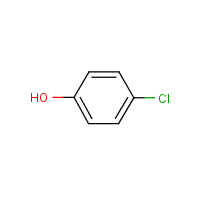4-Chlorophenol
Agent Name
4-Chlorophenol
CAS Number
106-48-9
Formula
C6-H5-Cl-O
Major Category
Other Classes

Synonyms
4-Chloro-1-hydroxybenzene; 4-Hydroxychlorobenzene; 4-Monochlorophenol; Applied 3-78; P-Chlorophenol; Parachlorophenol; Phenol, 4-chloro-; Phenol, p-chloro-; p-Chlorfenol [Czech]; p-Chlorophenic acid; p-Chlorophenol; [ChemIDplus] UN2020
Category
Chlorophenols
Description
White solid; Yellow or pink if not pure; Unpleasant, penetrating odor; [Hawley] Off-white crystalline powder; [MSDSonline]
Sources/Uses
Used as a chemical intermediate for pesticides, dyestuffs, and pharmaceuticals; Also used as a denaturant for alcohol, selective solvent in refining mineral oils, antiseptic, soil sterilant, adhesion promoting agent, and local antibacterial agent in root canal therapy; [HSDB]
Comments
A strong skin, eye, and respiratory tract irritant; May cause CNS effects; [ICSC] Causes burns to eyes and skin; Adverse effects are similar to those of phenol; [HSDB] A corrosive substance that can cause injury to the skin, eyes, and respiratory tract; Inhalation may cause chemical pneumonitis; May be absorbed through skin; Effects in high-dose animal studies include convulsions; [MSDSonline] See "Phenol." See "CHLOROPHENOLS."
Biomedical References
Exposure Assessment
Vapor Pressure
0.089 mm Hg
Odor Threshold Low
1.2 ppm
Lethal Concentration
LC50 (rat) = 1,010 mg/m3/4H
Explanatory Notes
Flash point = 121 deg C; [Hawley] Odor threshold (recognition) from CHEMINFO; The Guide in the Emergency Response Guidebook is for "Chlorophenols, solid." VP from ChemIDplus;
NFPA
must be preheated
Adverse Effects
Neurotoxin
Other CNS neurotoxin
Hepatotoxin
Hepatoxic (a) from occupational exposure (secondary effect) or (b) in animal studies or in humans after ingestion
Nephrotoxin
Yes
Dermatotoxin
Skin burns
Diseases, Processes, and Activities Linked to This Agent
Processes
Industrial Processes with risk of exposure: